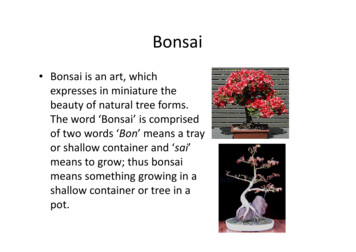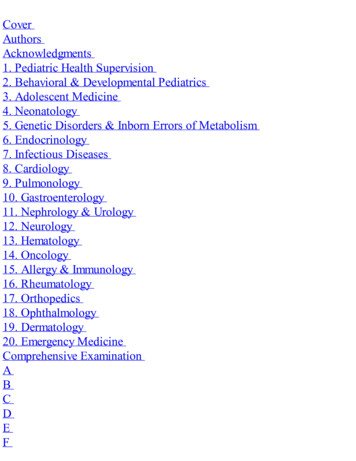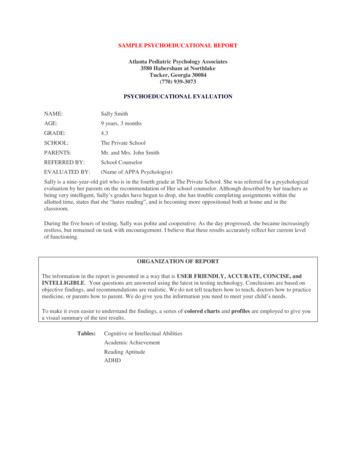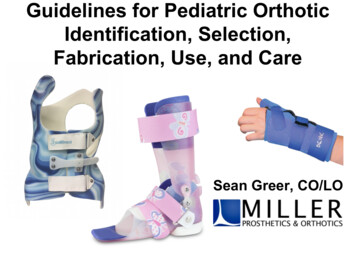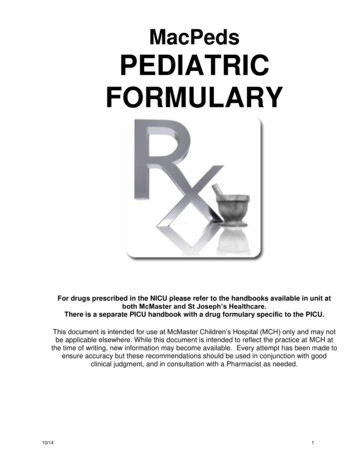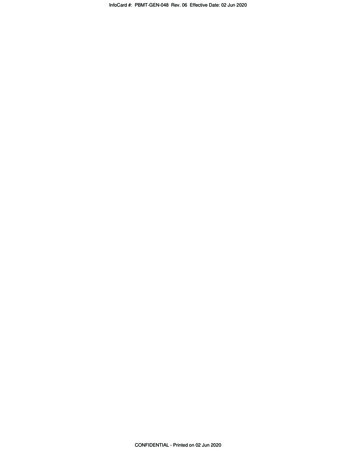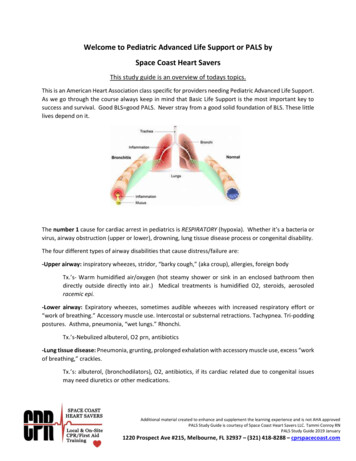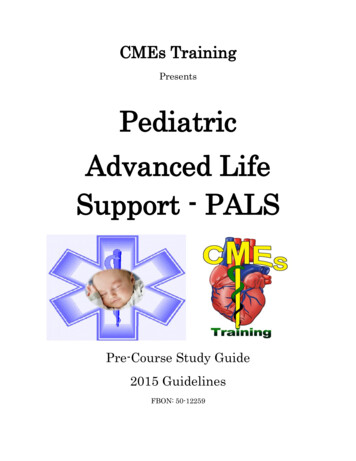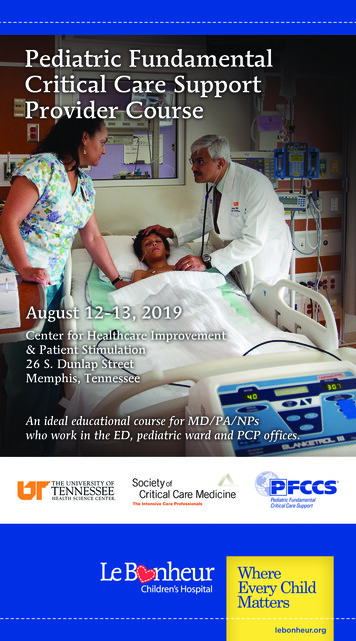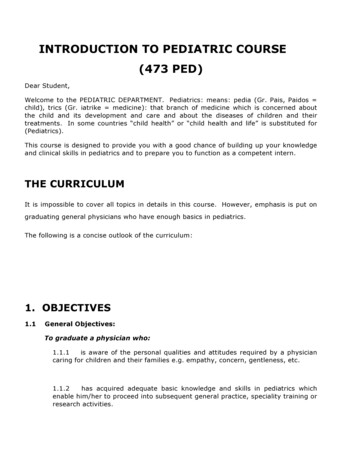
Transcription
INTRODUCTION TO PEDIATRIC COURSE(473 PED)Dear Student,Welcome to the PEDIATRIC DEPARTMENT. Pediatrics: means: pedia (Gr. Pais, Paidos child), trics (Gr. iatrike medicine): that branch of medicine which is concerned aboutthe child and its development and care and about the diseases of children and theirtreatments. In some countries “child health” or “child health and life” is substituted for(Pediatrics).This course is designed to provide you with a good chance of building up your knowledgeand clinical skills in pediatrics and to prepare you to function as a competent intern.THE CURRICULUMIt is impossible to cover all topics in details in this course. However, emphasis is put ongraduating general physicians who have enough basics in pediatrics.The following is a concise outlook of the curriculum:1. OBJECTIVES1.1General Objectives:To graduate a physician who:1.1.1is aware of the personal qualities and attitudes required by a physiciancaring for children and their families e.g. empathy, concern, gentleness, etc.1.1.2has acquired adequate basic knowledge and skills in pediatrics whichenable him/her to proceed into subsequent general practice, speciality training orresearch activities.
1.2Specific Objectives:At the end of the course the student is expected to:1.2.1perform, record and interpret a full pediatric history.1.2.2carry out, record and interpret a complete physical examination in allpediatric age groups.1.2.3identify and solve common clinical problems in pediatrics by providing aprovisional diagnosis and appropriate differential diagnosis.1.2.4recognize urgent and emergency situations in pediatrics and be able tooutline an appropriate plan of action.1.2.5outline a general plan of investigations and management of commonpediatric problems as they relate to Saudi Arabia.1.2.6demonstrate an understanding of how to use the laboratory to reach adiagnosis of common pediatric problems .1.2.7demonstrate knowledge of community problems related to child health.1.2.8demonstrate knowledge of preventive aspects of childhood healthproblems and to implement them.1.2.9recognize his limitations concerning management of pediatric patientsand the need to consult and cooperate with others to provide optimumcare.1.2.10 interact with children and their parents or relatives in a gentle, emphaticand appropriate manner.
2.Instructional strategies:2.1Lectures and TutorialsSeries of lectures covering selected topics in pediatrics will be deliveredto all students together during the whole course. Eight tutorials each willbe given 4 times. Each time will include one major group (A, B, C, orD). Students are expected to come fully prepared for the tutorialsessions. The tutors were encouraged to distribute handouts to thestudents before the tutorials to help them prepare.TOPIC CONTENTS OF THE COURSE2.1.1Development and behavior in pediatrics§ Normal development§ Developmental assessment§ Developmental delay (excluding mental retardation)§ Behavior-2.1.2Normal versus abnormalCommon behavioral problems (e.g., temper tantrum, attentionseeking, etc.)Nutrition§ Breastfeeding§ Bottle feeding§ Normal nutritional needs§ Protein-calorie malnutrition§ Failure to thrive§ Obesity§ Vitamin deficiency (e.g. Vit. D deficiency)
2.1.3Neonatology§ Normal newborn§ Common disorders; respiratory distress, sepsis, others2.1.4Genetics§ Basics of inheritance§ Approach to dysmorphic children§ Examples of common syndromes e.g., Trisomy 21, 13, 18; Turnersyndrome2.1.5Metabolic disorders§ Presentation and detection§2.1.6Approach to suspected metabolic diseases e.g., galactosemia,aminoacidopathies, organic academia, storage diseasesAllergy, Immunology and immunization§ Basics of immunity§ Common Allergic conditions§ Common immune deficiency disorders§ Active and passive immunization2.1.7Rheumatic and autoimmune disorders§ Juvenile rheumatoid arthritis§ Systemic lupus erythematosus§ Myositis§ Henoch-Schonlein purpura
§ Kawasaki syndrome2.1.8Infectious Diseases§ Common infections:Measles, chicken pox, rubella, scarlet fever, stomatitis, tonsillitis,otitis media, URI, sinusitis, infectious mononucleosis, cellulites,congenital infections, poliomyelitis, tetanus§ Serious infections:Meningitis, encephalitis, osteomyelitis,malaria, leishmaniasis, HIV ology and hepatology§ Acute and chronic diarrhea and constipation§ Structural and functional disorders of the GI tract§ Childhood liver diseases (infantile cholestasis, hepatitis, liver failureand metabolic liver disease)2.1.10Respiratory tract diseases§ Disorders of the upper airway§ Disorders of the lower airway2.1.11 Congenital and acquired heart diseases§ Common congenital defects§ Rheumatic fever§ Infective endocarditis§ Heart failure§ Common arrythmias in children
2.1.12Hematology§ Common hematological problems (anemias)§ Disorders of hemostasis2.1.13Oncology§ Pediatric malignancies§ Side effects of chemotherapy2.1.14Diseases of urinary system§ Nephrosis-nephritis-renal failure§ UTI and obstructive uropathies2.1.15Fluid, electrolytes and acid base disturbances2.1.16Neurology§ Seizure disorders§ Mental retardation and cerebral palsy§ Neuromuscular disorders and hypotonia2.1.17Endocrine disorders§ Thyroid, adrenal and bone mineralization disorders§ Polydipsia, polyuria and blood sugar disorders§ Disorders of growth and puberty2.1.18Dermatology§ Description
§ Neonatal skin rashes§ Dermatitis§ Skin infections2.1.19Emergency§ Coma§ Shock§ Burns§ Other common pediatric emergencies2.1.20Poisoning§ Treatment§ Prevention§ Environmental hazards2.2Clinical Teaching:2.2.1Formal teachingTwo (2) bedside teaching sessions are conducted by a teaching staffeach week. Usually cases are prepared by students who present it tothe group for discussion to demonstrate the relevant historical data andphysical findings. Activity takes place from 9:00 – 12:00 PM.Students will be divided into 12 groups to be posted into differenthospitals for them to swap posting at a certain time of the cycle.2.2.2ER, OPD, Nursery & Ward rotationsDuring rotations, students in each subgroup are divided into smallgroups of 3-5 students each. They rotate through: Ward, ER, OPD, orNursery (level 1 and 2 only).
During the ward rotation, each student should follow 1-2 patients at atime. The student is expected to function as a “sub-intern” with directinvolvement in patient care. They are expected to clerk patients,observe different aspects of inpatient care and share in the rounds withthe team.In OPD or Nursery sessions each subgroup is divided into 2, one halfattends in the morning and the other in the afternoon.In ER sessions each sub group is divided into 3, each will attend a 4hours shift: 8-12, 12-4, and 4-8. The shifts should rotate in differentsessions.2.3Attending the continuous medical education in thedepartment.(See attached schedule)NOTES:1.2.3.Students who are doing ward and those who are having clinicalsessions, except those who are preparing cases, are required to attendthe morning report at 8:00 in the Pediatric Seminar Room.Each student should:a)Wear white coatb)Wear his / her I.D.c)Bring his / her own equipmentd)Dress according to the dress code assigned by the college.Evaluation of studentsDuring each rotation, medical students will be evaluated by:[1]totalContinuous Assessment Evaluation – which holds 40% of the
marks and consists of:[2](a)Attendance of all activities – 5 marks(b)Presentation and discussion during clinical sessions – 4 marks(c)Clerking of clinical cases (3) – 6 marks (on 2nd and 3rdclerking)(d)Written examination (MCQs)* – 25 marksFinal Examination – which holds 60% of the total marks andconsists of:(a)Written examination (MCQ)* - 40 marks(b)OSCE-20 marks* Some MCQs are based on pictures.§ Student who score ³ 60 marks out of 100 (total course mark) will passthe course.4.Absences:§ Five (5) marks for attendance of lectures, clinical sessions, tutorials, ER, OPD,nursery and ward. 0.25 marks will be deducted for each absence from anyof these sessions.§ The absence from every form of activities (lectures, tutorials, clinical sessions,ER, OPD, ward, or nursery) will be accounted for. If the cumulative absencerate exceeds 20 activities, which is more than 25% of total course activities,a letter regarding the concerned student will be sent to the Vice Dean ofAcademic Affairs and the student will not be allowed to take the finalexamination.
RECOMMENDED BOOKS FOR THEPEDIATRIC COURSE 473BOOK TITLE1.Illustrated Textbook of PaediatricsAUTHOR(s) /EDITORTom LissauerGraham Clayden2. Nelson Essential Pediatrics3.Pediatric ClinicalKliegman / Marcdantel / Jenson /BehrmanGill and O’BrienExamination4. Illustrated Self Assessmentin PediatricsGraham RobertsCaroline FosterMichael CorenTom Lissauer5. «·ÿ›·: «· «—ÌŒ «·„— Ì Ê «·›Õ’ «·”—Ì—Ì .œ. »œ«··Â »‰ ”·Ì„«‰ «·Õ—»‘
GUIDELINES FOR CLERKINGPurpose:The purpose of the case study is mainly to train the student to take a thoroughhistory and perform a comprehensive physical examination.In addition thestudent, through this exercise, writes down his/her thoughts about the patient’sproblem(s) and formulates his/her plan of action to solve it.It helps thestudents think critically in a problem solving manner. The student can look at thepatient’s file (chart) and should discuss the case with the treating team as well.History Taking:Starting with the patient’s demographic data and presenting complaint and itsdetailed history, the student takes a full history as he is taught to do so andaccording to the guidelines.Physical examination:It is important that the student examines the patient thoroughly as he/she haslearned it, and according to the acceptable medical standard. Often times athoroughly performed physical exam can discover some findings that may or maynot be related to the patient’s problem.Accordingly, a complete physicalexamination must be performed or at least attempted. It is wise, however, to doa problem oriented physical examination more in depth to better delineate thepatient’s problem.
Summary:A brief summary of the history and physical examination is advisable here.Problem List:All the problems that the patient has as obtained by the history and the physicalexamination need to be listed down at this stage. It is important to put down themost important problems (e.g. most serious, most urgent, or most agonizing tothe patient) at the top of the list.All problems that the patient has especially those that affect his well-beingwhether organic or psychosocial need to be listed he provisional diagnosis is the one that best explains the patients’ symptomsand signs and encompasses as many of the patients problems as possible.The differential diagnoses are alternative possibilities that fit the symptoms andsigns but to a lesser degree.Each diagnosis, whether the prime one or the alternatives (differential) ones,needs to have the supportive evidence and negating points mentioned.
Management Plan:Management includes investigations and treatment:Investigations:The student must suggest the investigations required whether hematological,other boy fluids or tissues or radiological. Each investigation suggested must beaccompanied by sound reasoning’s as to why it should be done. Investigationsneed to be prioritized.Other services:The help of other services or sub-specialties can be mentioned if need be.Treatment:Base on the aforementioned information and findings the student is expected towrite down his plan of treatment with sound rationalization.At this stage the student is allowed to look at the patient’s file. The student isexpected to compare his findings, thoughts, and plans with those in the file andto give his comments.Follow-up:On a daily basis the student has to report on the patient’s condition as well asany plans after discussion with the team, following the patient. Daily progressnotes should be written using the SOAP format.
The SOAP format should be used asfollows:§ S (Subjective): Changes in the patient status, in the patient’s or hisguardian’s words.§ O (Objective): Vital signs, examination of concerned system(s), and newinvestigations results.§ A (Assessment): Your interpretations and evaluation of the patient conditionbased on the subjective and objective data.§ P (Plan): Your decisions based on the assessment (e.g. order a newinvestigation, add or stop a medication).Prognosis and future plan:The student has to give his/her opinion regarding the prognosis. The student, aswell, must write down the future plan for the patient (irrespective of whether thepatient has been discharged or not).General Comments:The student is required to write down a brief comment on the overallmanagement care and plans for the patient.
TEACHING CLASS MANNERSDear Students,Please take note of the following manners and behaviors during teachingsessions (lecture or bedside teaching);1)You have to comply with the agreed college dress code for students. Studentswearing differently will not be allowed to attend the class.2)Students should be seated in the class on time. Late comers will not be allowedto join class and will be regarded as absent.3)Chewing gum, drinking, eating and inappropriate talking to colleagues disturbingthe class is strictly prohibited.4)Sick or sleepy students are not supposed to attend class. Permission or sickleave is a better alternative.5)Bleeps and cellular phones are expected to be inactivated during the class.6)Teacher have the right not to grant permission for attending class and expectedto send students away if none of the above manners were observed.WEEKLY DEPARTMENTAL ACTIVITY (KKUH)PLACE: SEMINAR ROOM, DEPARTMENT OF
PEDIATRICSDAYTIMEACTIVITIESSaturday8:00 – 8:30 AMMorningAdmission Rounds(GENERAL)Sunday8:00 – 9:00 AMCase PresentationMonday8:00 – 8:30 AMMorningAdmission Rounds(NICU,PICU,ER,OPD)Tuesday8:00 – 9:00 AMGrand RoundsWednesday8:00 – 8:30 A
1. Illustrated Textbook of Paediatrics Tom Lissauer Graham Clayden 2. Nelson Essential Pediatrics Kliegman / Marcdantel / Jenson / Behrman 3. Pediatric Clinical Examination Gill and O’Brien 4. Illustrated Self Assessment in Pediatrics Graham Roberts Caroline Foster Michael Coren Tom Lissauer Ì—ÌFile Size: 204KBPage Count: 25
